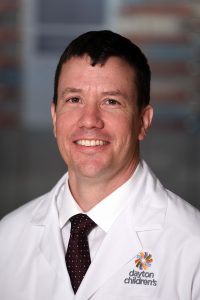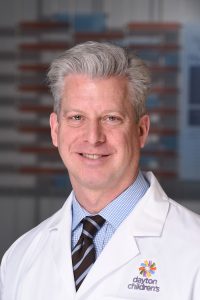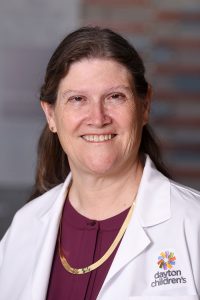
Robert Lober, pediatric neurosurgeon at Dayton Children’s and associate professor of pediatrics and neuroscience, cell biology and physiology at Wright State.
While the road for twin Guatemalan boys with a rare condition remains bumpy and full of pitfalls, their lives have been infinitely improved by the hard work and dedication of surgeons associated with the Wright State University Boonshoft School of Medicine.
A surgical team from Dayton Children’s Hospital, which included Boonshoft School of Medicine faculty members Robert Lober, M.D., Ph.D., Christopher Gordon, M.D., and Cheryl Kuck, M.D., separated the conjoined twins through a series of operations over the past two years.
The boys, Pedro and Augusto, who turned 5 on Sept. 11, first came to Dayton Children’s in July 2021 joined at the top of the head with a 90-degree turn. Classified as having craniopagus O’Connell class III, approximately 50 sets of twins are born with this rare condition annually, with only 15 of those sets surviving more than a few months, according to hospital officials.
“It’s been a long journey, and it will become clearer over time what their lives will ultimately be like,” said Lober, pediatric neurosurgeon at Dayton Children’s and associate professor of pediatrics and neuroscience, cell biology and physiology at Wright State. “At first you think, ‘Did we do the right thing?’ when you realize it’s going to be such a struggle for them to recover. But now that you see them wanting to play and be with other kids … that is very rewarding. Risks needed to be taken in order for them to have a chance at a normal life.”
Before the procedures, the boys experienced developmental delays and functional disabilities, were beginning to show signs of organ failure, and faced the prospect of spending the majority of their lives in a hospital.
Gordon, chief of craniofacial and plastic surgery at Dayton Children’s and clinical professor of orthopedic and plastic surgery at Wright State, learned about the boys while working on cleft surgeries in Guatemala.
Because there have been few surgeries of this type performed and little data collected, determining success was difficult, said Lober. But after researching and assembling the right team, Lober and Gordon thought separation could be achieved through a series of surgeries.

Christopher Gordon, chief of craniofacial and plastic surgery at Dayton Children’s and clinical professor of orthopedic and plastic surgery at Wright State.
After four surgeries in two years, and with the assistance of nearly a half-dozen organizations, the boys were officially separated on April 8 during a procedure that spanned three days.
Preparation was further complicated when two surgeons mentoring the team most familiar with this type of procedure died from COVID-19 during the planning stages.
“We kind of went off the reservation and had to create our own plan,” said Lober. “We developed the right team, spent hundreds of hours of training and performed numerous mock drills. This was a big success for the hospital.”
Even though they were well-prepared, the team inevitably encountered a few surprises, said Gordon, who added that the boys’ safety was of the utmost concern and that the twins remained strong and resolute throughout the process.
Kuck, a pediatrician and director of palliative care services or Dayton Children’s and assistant professor of pediatrics and geriatrics at Wright State, was asked to join the team to serve as a point of contact among the specialists and bridge communication between the team and the family.
She said that because it was groundbreaking surgery, the team did not know what was going to happen with the boys.
“This was more than a surgery,” Kuck said. “It brought us together for a common good. The dedication that the entire staff put into this case was incredible. There were so many people praying for the children. The ripple effect and the impact they had was magnificent.”

Cheryl Kuck, a pediatrician and director of palliative care services or Dayton Children’s and assistant professor of pediatrics and geriatrics at Wright State.
Pedro and Augusto currently reside in a family-based group home for children with special needs in Guatemala run by Hope for Home Ministries in Troy, Ohio. Lober said the twins will face major challenges, including speech delays and walking difficulties, but given their age, they have sufficient recovery time to get their functions back.
“It’s hard to find two happier kids,” he said. “They bring joy to everyone they’re around.”
Now that Dayton Children’s Hospital has a team and infrastructure in place, the plan is to initiate a craniofacial program to care for children from all over the world.
The medical team conducts weekly updates to gauge the boys’ progress and constantly communicates with caregivers in Guatemala. Lober said he hopes to visit them during the holiday season.
“It’s something you never get used to,” Lober said of performing the life-altering surgeries. “You’re holding kids’ hopes and dreams in your hands.”
A documentary chronicling the process is available on Dayton Children’s Hospital’s YouTube page.

 Wright State alum Lindsay Aitchison fulfills childhood space-agency dream
Wright State alum Lindsay Aitchison fulfills childhood space-agency dream  Wright State business professor, alumnus honored by regional technology organizations
Wright State business professor, alumnus honored by regional technology organizations  Wright State University Foundation awards 11 Students First Fund projects
Wright State University Foundation awards 11 Students First Fund projects  Gov. DeWine reappoints Board Treasurer Beth Ferris and names student Ella Vaught to Wright State Board of Trustees
Gov. DeWine reappoints Board Treasurer Beth Ferris and names student Ella Vaught to Wright State Board of Trustees  Joe Gruenberg’s 40-Year support for Wright State celebrated with Honorary Alumnus Award
Joe Gruenberg’s 40-Year support for Wright State celebrated with Honorary Alumnus Award 